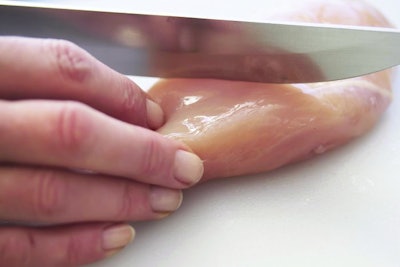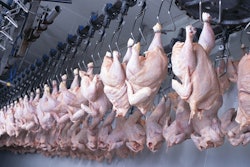
Forty-three percent of the poultry meat sold in France over the first five months of 2022 was produced overseas, and where chicken is concerned, the figure was even higher.
French poultry producers have been gradually losing market share to cheaper poultry meat imports and, over the last couple of years, this trend has accelerated.
According to figures released by the country’s broiler producers’ association ANVOL, in 2000, imports accounted for only 24% of the French market. By 2021, this figure had risen to 39%.
Imports may have declined in 2020, which the association says was an atypical year, but their upward trend returned in 2021 and continued into 2022. Over the first five months of 2022, imports grew by 13.6%, in comparison with the same period the year before.
The market for chicken has been most affected. In 2020, 41% of the chicken consumed in France was produced outside of the country. This rose to 45% in 2021 and reached 49% over the fist five months of 2022.
The situation is less marked where turkey and duck meat are concerned. ANVOL notes that 19% of turkey meat is imported and 14% of duck meat whereas the market for guinea fowl meat is unaffected.
Imported poultry meat is cheaper than that produced in France, and its production, ANVOL argues, is not subject to the same rules, regulations and good working practices applied in France.
Local industry response
Keen to recover lost ground on its home market, ANVOL says that it wants to offer poultry meat for all occasions, but it also wants foreign producers selling into France to strictly comply with the rules that French producers must follow.
The association is calling on the EU to halt new trade agreements that increase poultry import quotas and would lead to more foreign poultry meat entering France. It also wants a strengthening of mandatory label of origin requirements.
The association says that approximately nine out of 10 French consumers have expressed a preference for locally produced poultry, and it is calling for mandatory use of the Volailles Françaises origin logo in restaurants and on poultry meat and products that contain it.
It also wants help to develop what it calls everyday chicken farms and a pause to EU regulations that are hindering the modernization of the local industry.
Where trade is concerned, ANVOL is calling on the EU to adopt mirror clauses, to ensure that imported products are produced to the same standards as those followed in Europe. Imported poultry should be produced not simply in an equivalent way, but in the exact same way as poultry meat produced in France.
In light of the increased imports from Ukraine, which the association notes do nothing to help Ukrainian poultry producers but instead favor the interests of one large Ukrainian producer and harm French production, the association has expressed alarm at new agreements with Mercosur and Chile.
Ukraine is able to take market share due to lower labor costs and by not being aligned with EU regulations or following French good practice. Raising import quotas from Chile and Mercosur, which similarly do not produce to the same high standard as European producers, has been described by the association as incomprehensible, and it has called on the French government to not ratify a new commercial agreement between the EU and Mercosur and Chile.
The origin of poultry meat imports
The largest poultry meat exporters to France are other EU Member States. Over the first half of 2022, imports from Poland, the EU’s largest poultry meat producer, rose by 22%, those from Belgium were 21% higher, while from the Netherlands imports dropped by 1.7%. ANVOL notes, however, that some of the meat exported from Belgium and the Netherlands originates from third countries.
Shipments from Ukraine to France rose by 22% over the first half of 2022 while those from Brazil were up by 18%.

Changing fortunes
France has long been the EU’s second largest poultry producer, accounting for approximately 13% of the bloc’s output.
The country is Europe’s largest consumer of poultry meat, and consumption continues to rise. However, production is thought to have contracted by close to 10% last year.
ANVOL attributes this contraction, which could see the country slip to fourth place, to rising production costs, disease outbreaks and ongoing pressure from imports.
The volume of poultry meat consumed in France continues to rise, but ANVOL warns that these pressures are putting the local industry in jeopardy.
EU imports of poultry meat in 2020 and 2022 were lower than during the previous two years, according to data from the EU’s Directorate-General of Agriculture and Rural Development. However, over the first eight months of 2022, imports rose by 32% compared to the same period the year before.
French poultry production to end year significantly lower
















